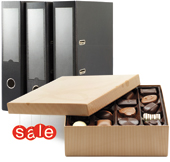Making the Price of Indulgence Right
Want to increase sales of a bundle of goods or services that includes both pleasurable and utilitarian items? Research suggests that a discount will increase sales more effectively if it’s offered on the pleasurable item.
Topics

Three groups of consumers were offered an opportunity to buy a bundle of items — a box of chocolates and a set of binders — at a discount. Those who were told that the discount was offered on the chocolates were more likely to buy the bundle.
Offering consumers a price discount if they purchase a bundle of goods or services together is a common promotional tool. While conventional marketing practice has been to offer bundles that consist of complementary items — for example, a beverage, sandwich and French fries in a fast-food restaurant — the practice of offering cross-category bundles is growing. One reason: In online retail settings, technology makes it feasible for websites such as Amazon.com to bundle different types of products easily.
What happens when consumers face a bundle that consists of one item that is desired more for pleasure and indulgence — what we call a hedonic item — and one that is more practical and functional in nature? Three experiments we conducted, which were described in detail in the December 2010 issue of The Journal of Marketing Research, suggest that businesses considering offering such bundles will achieve better results if they associate the discount with the price of the more pleasurable, less utilitarian item in the bundle.
For example, in one study we offered consumers an opportunity to buy discounted products. The items were a box of chocolates — a pleasurable item — and a utilitarian set of three binders. The individual options were each offered at $6. However, an additional $2 discount was offered on the bundled purchase of both the items. Consumers were randomly divided into three groups. The first group was told that they could save $2 on the chocolates if they also purchased the binders. The second group was told that they could save $2 on the binders if they also purchased the box of chocolates. The third group was told that they could save $2 on the total purchase for buying both the binder and the box of chocolates. Although the amount of discount was the same across the three groups, the purchase results showed that the way the discount was framed had a significant impact on sales of the bundle.
